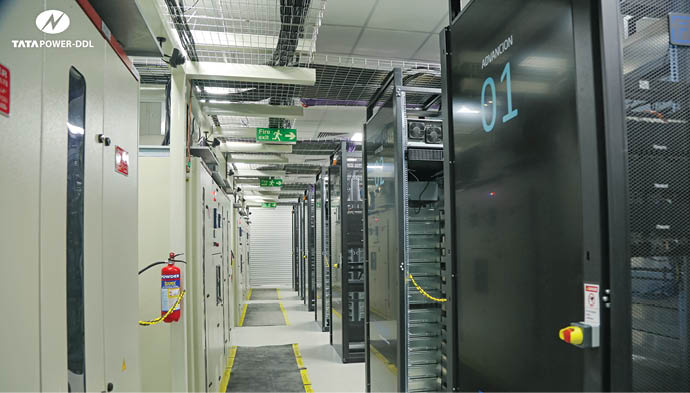Tata Power Delhi Distribution Limited (Tata Power-DDL) is at the forefront of India’s energy transition, being one of the first distribution companies (discoms) to adopt cutting-edge technologies such as Advanced Metering Infrastructure (AMI), smart grids, and Supervisory Control and Data Acquisition (SCADA) systems. These systems are vital for addressing the complexities of modern energy distribution and maintaining grid stability in the face of fluctuating renewable generation. In an exclusive interview with Wire and Cable India, Mr. Gajanan S. Kale, Chief Executive Officer of Tata Power-DDL, delves into the company’s technological advancements and strategic initiatives aimed at supporting India’s ambitious target of achieving 500 GW of non-fossil-based electricity capacity by 2030. He highlights how Tata Power-DDL’s proactive adoption of modern infrastructure is setting new horizons for the energy sector, positioning the company as a leader in driving the country’s clean energy transition goal.

Wire and Cable India: Can you provide an overview of your company, its history, and key milestones in the power transmission and distribution sector? What is your company’s core expertise in the T&D industry?
Gajanan S. Kale: Tata Power Delhi Distribution Limited (Tata Power-DDL) is a leading power distribution company in India, serving around 9 million people in North and Northwest Delhi. Established in 2002 as a joint venture between Tata Power, India’s largest integrated power utility, and the Government of NCT of Delhi, Tata Power-DDL has consistently been at the forefront of innovation and excellence in the power sector.
Since its inception, Tata Power-DDL has marked several key milestones, reshaping Delhi’s power distribution landscape. Notably, we reduced Aggregate Technical and Commercial (AT&C) losses from 53% in 2002 to below 6%—an achievement unmatched in India’s power distribution sector.
We were also among the first Indian discoms to adopt cutting-edge technologies like Advanced Metering Infrastructure (AMI), smart grids, and Supervisory Control and Data Acquisition (SCADA) systems, significantly enhancing operational efficiency and service reliability.
In 2021, we pioneered the integration of Artificial Intelligence (AI) for energy system modelling and forecasting, setting new benchmarks for predictive analytics and decision-making in the power sector.
Our core expertise lies in leveraging advanced technologies and sustainable practices to ensure reliable, efficient, and consumer-focused power distribution. We specialize in areas such as grid modernization, renewable energy integration, energy efficiency, and consumer-centric innovations.
Additionally, the Tata Power-DDL learning centre plays a crucial role in upskilling talent across the industry, reinforcing our commitment to excellence and leadership in the Transmission and Distribution (T&D) sector.
WCI: What is your outlook for the transmission and distribution sector by 2030? How would you describe the current market sentiment, and what key trends do you anticipate driving the sector’s evolution?
GSK: The ambitious goal of achieving 500 GW of non-fossil-based electricity capacity by 2030 hinges on the development of a robust, reliable, and well-integrated transmission network. To address this challenge, the Indian government, through the Ministry of Power, has established a high-level committee comprising representatives from the Central Electricity Authority, Solar Energy Corporation of India, and Power Grid Corporation of India. This committee is tasked with devising a comprehensive roadmap for integrating over 500 GW of renewable energy capacity into the grid, ensuring a sustainable and dependable power supply.
Tata Power Delhi Distribution Limited highlights the pivotal role of public-private partnerships in realizing this vision. Strengthening transmission and distribution networks in step with the expansion of renewable energy capacity will be crucial to effectively meeting future energy needs while supporting the transition to a sustainable energy future.
Watch: Top Cable Companies in India
WCI: Could you elaborate on the technologies and equipment your company uses in power transmission projects?
GSK: Tata Power-DDL leverages cutting-edge technologies and state-of-the-art equipment to ensure efficient, reliable, and sustainable power transmission. Our projects incorporate advanced Supervisory Control and Data Acquisition (SCADA) systems for real-time monitoring and control, as well as Geographic Information System (GIS)-based substations that enhance operational efficiency and asset management.
We have employed smart grid technologies, and advanced communication networks to ensure seamless integration of renewable energy sources and load management. Additionally, high-performance transformers, circuit breakers, and XLPE cables are utilized to minimize energy losses and enhance system reliability.
Recently, we have initiated a collaboration project of creating a micro-substation with power voltage transformer, to enable supply of cost-effective & stable power to remote areas across India.
Our commitment to innovation and sustainability is further exemplified by the adoption of green energy solutions and energy storage systems to support the growing demands of urban and industrial customers while maintaining environmental stewardship.
WCI: What new technologies will play a crucial role in the near future, and what does the future smart grid adoption look like in India?
GSK: The future of India’s power grid depends significantly on integrating emerging technologies to enhance its reliability, flexibility, and sustainability. As one of the largest synchronous grids globally, India’s grid must evolve to meet growing energy demands, integrate increasing renewable energy sources, and improve operational efficiency. The adoption of cutting-edge technologies will be central to achieving these objectives.
A future-ready grid requires advanced automation systems capable of real-time monitoring, control, and optimization of energy flows. Innovations such as smart grids, Advanced Metering Infrastructure (AMI), and Demand Response Systems will be indispensable for enhancing efficiency, minimizing outages, and managing demand-supply dynamics effectively.
With the rapid adoption of renewable energy sources like solar and wind, which are inherently intermittent, energy storage solutions will be vital. Technologies such as battery storage and pumped hydro storage will enable the capture of surplus renewable energy during low-demand periods and its deployment during peak hours, thereby stabilizing the grid and reducing reliance on fossil fuels.
Artificial Intelligence (AI) and Machine Learning (ML) will revolutionize grid management by enabling predictive maintenance, optimizing operations, and enhancing asset management. These technologies can process vast amounts of real-time data from sensors and grid infrastructure, predict failures, detect anomalies, and improve decision-making. Additionally, AI and ML can forecast energy demand patterns, ensuring smarter grid planning and resource allocation.
The rise of Distributed Energy Resources (DERs) like rooftop solar, electric vehicles (EVs), and small-scale wind or hydro systems calls for a shift toward decentralized grid architectures. Micro-grids will support localized energy generation and consumption, improving resilience and reducing transmission losses. These advancements will also empower consumers, facilitating active participation in energy management, including peer-to-peer energy trading.
Furthermore, with India’s ambitious EV adoption targets, integrating EV charging infrastructure into the grid will be critical. Smart charging systems and vehicle-to-grid (V2G) technologies will not only enable EVs to charge during off-peak hours but also allow them to supply energy back to the grid during peak demand, dynamically balancing supply and demand while supporting grid stability.

We reduced Aggregate Technical and Commercial (AT&C) losses from 53% in 2002 to below 6%, an achievement unmatched in India’s power distribution sector.
WCI: What are the biggest challenges your company faces in the T&D sector? How do you address transmission losses, and what strategies are you implementing to improve efficiency?
GSK: Building power transmission lines is one of the most complex tasks in the power sector. Several challenges arise from factors like terrain, availability of skilled manpower, weather conditions, project timelines, and environmental clearances. Another significant hurdle is the lack of clear guidelines for projects passing through eco-sensitive areas.
However, it’s important to recognize the proactive role played by the government and its agencies in assisting power transmission service providers. They are addressing many of these challenges through policy changes and updates to bidding guidelines. The overall power sector must align the generation, transmission, and distribution systems to avoid any fallouts and hence a robust infrastructure is essential for a smooth operation.
The government’s evacuation plan to integrate 500 GW by 2030 is a crucial step in the right direction. Additionally, the ‘Gati Shakti’ portal can play a vital role in improving communication, expediting approvals, and ensuring timely project execution.
Technology will remain a driving force in revolutionizing the transmission sector. Technologies like helicopter stringing, helicopter cranes, AI, and drone surveillance have proven highly effective in overcoming challenges related to transmission infrastructure in challenging terrains like Jammu & Kashmir, Ladakh, Uttarakhand, and the north-eastern regions.
Drones, for instance, are now widely used for monitoring transmission lines, reducing the need for human intervention and facilitating quick fault detection and resolution. Similarly, AI-powered SCADA systems are optimizing substation operations, reducing manual oversight.
Other ongoing challenges faced by T&D companies include demand fluctuations, insufficient infrastructure, network encroachment, power theft, and maintaining customer satisfaction.

WCI: How do emerging technologies like artificial intelligence and digitalization contribute to advancing sustainability and other critical aspects of T&D projects?
GSK: Tata Power Delhi Distribution Limited has been a pioneer among Indian power distribution companies in harnessing the potential of Artificial Intelligence (AI) for energy system modeling and forecasting. As early as 2018, Tata Power-DDL introduced an innovative AI solution designed specifically for Indian discoms to enhance operational efficiency and intelligence. Since then, the company has taken significant strides, including forging partnerships with leading AI-specialized firms, to further advance its capabilities.
The application of AI in energy system modeling and forecasting has proven instrumental in reducing unpredictability and improving efficiency in power balancing and utilization. Additionally, the discom is now leveraging AI for predictive maintenance of grid infrastructure, enabling the early detection of potential issues, minimizing disruptions, and ensuring a more reliable power supply.

We specialize in areas such as grid modernization, renewable energy integration, energy efficiency, and consumer-centric innovations.
WCI: When it comes to exports, how can India strengthen its position in the T&D sector? Are there any key takeaways or lessons India can adopt from international practices?
GSK: As India continues its journey toward becoming a global energy leader, significant opportunities emerge to expand exports in the transmission and distribution sector. With extensive experience in scaling infrastructure, driving technological innovation, and fostering a resilient energy ecosystem, India is well-placed to become a key exporter of T&D products, services, and solutions.
India’s progress in developing cost-effective and cutting-edge technologies, particularly in the renewable energy domain, underscores its potential. By prioritizing research and development (R&D) in areas such as grid automation, energy storage, smart grids, and high-efficiency transformers, India can enhance its global competitiveness.
Nations like Germany and South Korea have demonstrated how a strong focus on R&D in advanced components, such as smart grid technologies and renewable energy integration systems, can lead to thriving export markets.
Expanding India’s T&D exports requires strategic international partnerships with both developed and emerging markets. Collaborations with regions undergoing infrastructure growth, such as Africa, Southeast Asia, and the Middle East, present promising opportunities for India to share its expertise and solutions.
The global transition toward digital grids and smart cities creates new avenues for India’s T&D exports. By offering smart grid solutions, digital substations, and energy management systems equipped with real-time monitoring, predictive analytics, and automation, India can play a pivotal role in addressing the needs of a rapidly evolving global energy landscape.
Also Read: Maillefer Extrusion Sees Great Potential in Indian Renewable Power Transfer Sector
WCI: What are India’s key requirements for skilling in the T&D sector? What are the current gaps, and how can they be addressed effectively?
GSK: India’s T&D sector grapples with significant gaps in the sector, including insufficient training infrastructure, outdated curricula misaligned with industry requirements, and difficulties in attracting and retaining skilled talent. This skills gap is particularly pronounced in advanced areas such as artificial intelligence and cloud computing, limiting India’s competitiveness on the global stage.
Since its inception in 2002, Tata Power Delhi Distribution Limited has prioritized the training and skill development of its workforce. The Tata Power-DDL Learning Centre plays a pivotal role in this endeavor, offering targeted training programs designed to upskill employees from various State Utilities. These programs focus on sharing Tata Power-DDL’s transformative practices, equipping participants to adapt to industry changes, and addressing commercial and operational challenges in distribution operations.
WCI: Lastly, would you like to share a way forward for the T&D Sector in India?
GSK: India’s transmission and distribution sector is brimming with potential, and Tata Power-DDL is at the forefront of driving transformative advancements. The company has been striving to become a benchmark utility and have undertaken significant technological upgrades, including the replacement of outdated infrastructure with smart meters and high-capacity transformers, paving the way for a more efficient and modernized grid.
Through strategic measures to reduce Aggregate Technical and Commercial (AT&C) losses, Tata Power-DDL has successfully decreased dependency on government subsidies. The company has enhanced customer satisfaction by introducing initiatives such as digitized customer records and self-meter reading, making energy management more accessible and convenient for consumers.
The future growth of India’s T&D sector depends on addressing several critical factors. Strengthening state grids will be pivotal in ensuring reliable electricity supply to even the most remote regions. Robust investments in grid infrastructure are also necessary to efficiently handle the increasing share of renewable energy in the system.
Moreover, the electrification of high-demand sectors, including railways and metro systems, will drive a substantial rise in electricity consumption. This underscores the need for further upgrades to the T&D network to meet the growing energy demands while ensuring seamless and reliable power delivery.





